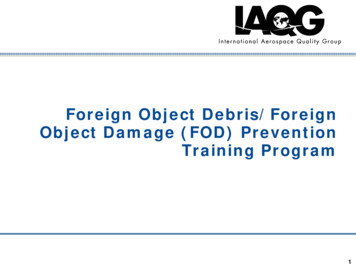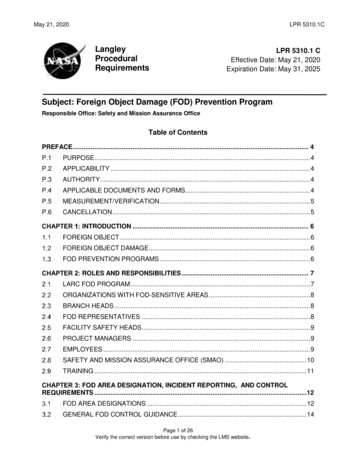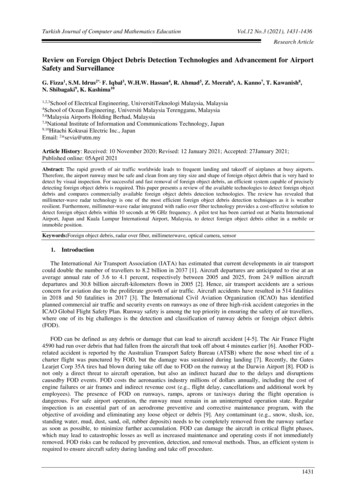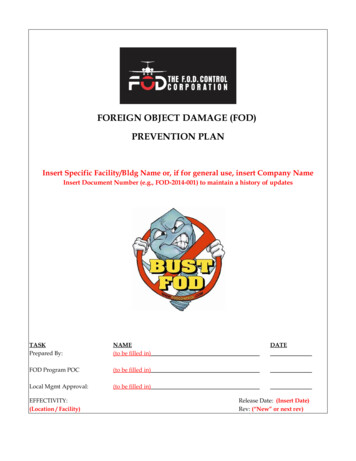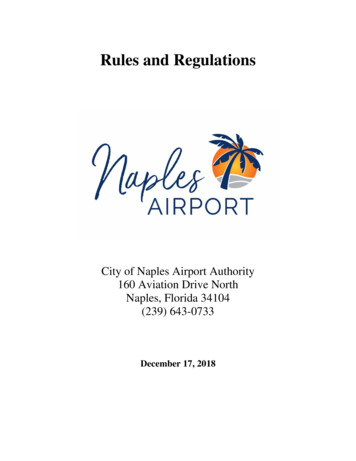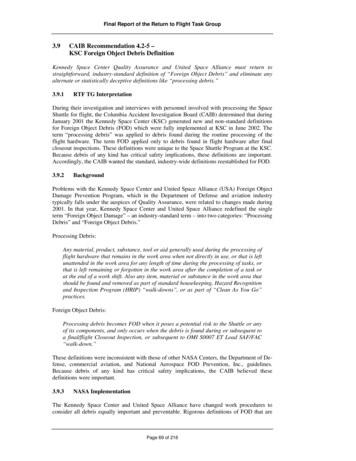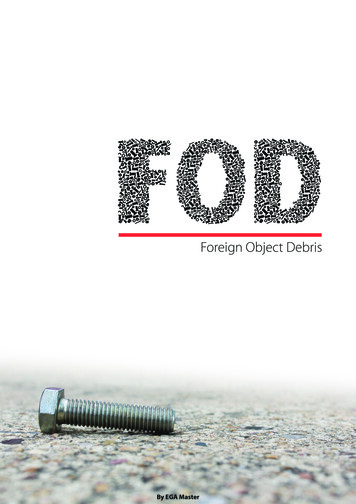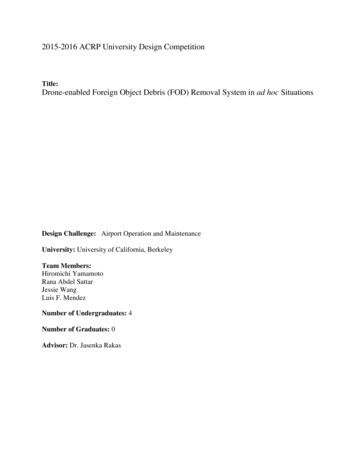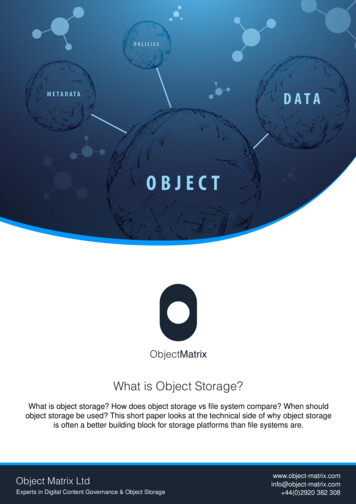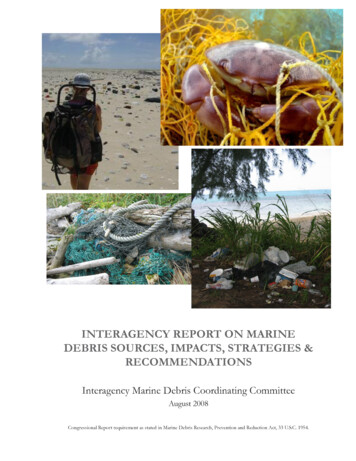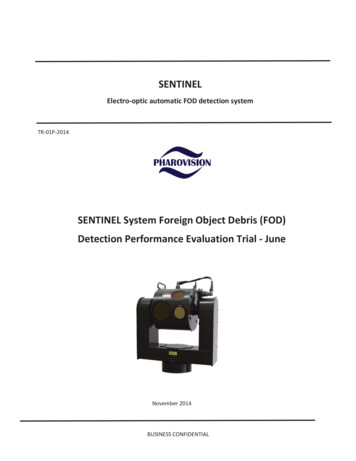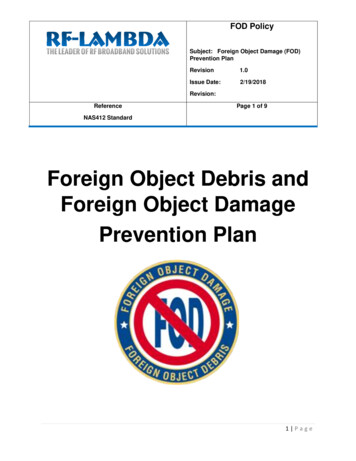
Transcription
FOD PolicySubject: Foreign Object Damage (FOD)Prevention PlanRevision1.0Issue Date:2/19/2018Revision:ReferencePage 1 of 9NAS412 StandardForeign Object Debris andForeign Object DamagePrevention Plan1 Page
Table of Contents1.0Objective . 32.0Scope: . 33.0FOD Program Definitions / Acronyms / Terms: . 34.0General Requirements: . 34.1Reference Documents: . 34.2FOD Prevention Training: . 44.3External/Visitor Requirements: . 44.4Housekeeping: . 44.4.1CAYG “Clean As You Go” : . 44.4.2"6S": . 54.5FOD Prevention Area Identification: . 54.6Personal Attire and Personal Items: . 54.6.14.7Designated Food/Drink Areas . 5Incident Reporting: . 54.7.1Incident Reporting Criteria: . 64.7.2Processing Incident Reports: . 64.8FOD Walk s / Walk Downs / Sweeps: . 64.9Records Retention Requirements: . 65.0Additional FOD Prevention Practices: . 75.1Equipment (Test, Support, and/or Facility) & Tooling Maintenance . 75.2Tool Accountability & Control . 75.2.15.3Tool Transportation . 8Miscellaneous Small Parts (MSP) and Consumables: . 8Page 2 of 8Revision No: 0
1.0Objective:This document details the policies and practices necessary to ensure that RF-LambdaUSA LLC supports the FOD-free fabrication, assembly, test and processing of allcomponents and products.2.0Scope:This plan applies to all manufacturing areas where parts are received, fabricated,assembled, packaged, shipped, stored and/or tested.3.0FOD Program Definitions / Acronyms / Terms: Foreign Object (FO) or Foreign Object Debris (FOD) – A substance, debris orarticle alien to an aircraft or system, which would potentially cause damage. Foreign Object Damage (FOD) - Any damage or malfunction attributed to aforeign object that can be expressed in physical or economic terms which may ormay not degrade the product’s required safety and/or performancecharacteristics. Potential FOD: The Condition where foreign object debris may causedamage/or failure should the product be put into use. Examples are:o Metal or wire clippings, solder balls and debris lying in the vicinity orelectrical terminals, circuitry, connectors, components, etc.Tools, hardware, or debris left in the vicinityo Personal items such as badges, hats, pins, pens, pencils, cell phones,pocket lights, keys and etc. normally carried loose on a person or in theirpockets.oForeign Object Elimination (FOE): a program or process used to assure a FODfree product/system.4.0 General Requirements:4.1 Reference Documents:The FOD Prevention Plan is designed to address the concerns outlined in the followingdocuments as related to product/process integrity: NAS 412, Foreign Object Damage / Foreign Object Debris (FOD) PreventionBell Helicopter Textron, Inc.ISO-9000 Quality Management StandardPage 3 of 8Revision No: 0
4.2 FOD Prevention Training:All personnel with access to FOD Sensitive Products/Areas shall receive FOD Preventiontraining, as well as any other group who may contribute to the generation of FOD. Trainingwill be in the form of workshops, and group discussions with some on-the-job training toincrease relevance and provide context. Management/ FOD POC is responsible forverifying that all employees working within affected areas/functions have completed therequisite training per company requirements.4.3External/Visitor Requirements:Visitors and other non-RF-Lambda individuals, contractors, and government agencypersonnel may be escorted within FOD Prevention Areas in lieu of training. If visitors arenot escorted, then they must receive a FOD program briefing or complete the employeetraining. The level of training required for visitors should be at the discretion ofmanagement/ FOD POC.4.4Housekeeping:Utilize normal "Clean As You Go" and "6S" routines to provide an organized andprofessional working environment for personnel and hardware processing. FOD walksshould be performed under the direction of management/ FOD POC when possible.4.4.1“Clean As You Go”:"Clean As You Go" is an aerospace industry standard routine for cleaning up work areasprior to, during and after work efforts. It is the continuous practice of debris removal andsurface cleanliness during manufacturing, maintenance or any operation involvingsensitive hardware, equipment or tools. The routine prevents accumulation of FOD, andthus greatly decreases the potential for FOD migrating into or damaging hardware.The following are good clean-as-you-go practices, and should be applied on an everydaybasis: Clean up the immediate and surrounding areas when work cannot continue.Clean up the area when work effort is complete.Clean up the area when departing for 15 minutes or longer.Clean up any generated debris that has the potential to migrate to an out of sightor inaccessible area.Clean up debris that has the potential to cause damage to hardware and/orwould give the appearance of poor workmanship or housekeeping to a customer.Clean up the area before the next planned operation in support of an inspectionpoint.Clean up the area prior to a work shift change or unplanned delay.Page 4 of 8Revision No: 0
4.4.2 "6S":"6S" is a lean manufacturing technique that helps organize a work area to optimizeefficiency. Areas setup and maintained using the 6S guidelines are less likely to generateFOD that will become entrapped or result in product damage.The "6S" acronym stands for:1. Sort: Separating needed materials/tools/etc from unneeded2. Straighten: Organizing everything in its place. Places should beidentified/marked.3. Shine: Establishing general cleanliness and cleaning routines/schedules4. Standardize: Maintaining and monitoring the 1st three S’s, and keepingconsistency across areas5. Safety: Removing hazards and mistake proofing procedures6. Sustain: Embedding “6S” into the culture, and instilling discipline4.5FOD Prevention Area Identification:FOD Prevention Areas are clearly identified by signage and/or boundary markers. Ifrequired, temporary FOD Prevention Areas can be established or existing FODPrevention Area controls and/or levels (if applicable) may change given the approval ofmanagement/ FOD POC.4.6Personal Attire and Personal Items:Proper working attire and control of personal items are essential to prevent theinadvertent invasion or damage to FOD sensitive products. Personal items must besecured or removed to prevent them from becoming FOD. Food and drink should not beallowed within the work area unless it is limited to designated areas.4.6.1Designated Food/Drink AreasThese areas must be clearly identified with signage and/or boundary markers.The consumption of food and drink items within the work area should be limitedto this area, and items should be transported to this area in a sealedbag/container to limit potential contamination of hardware.4.7Incident Reporting:Incidents involving foreign objects should be reported to management/ FOD POC andinvestigated to determine the root cause and appropriate corrective actions. The datacollected from incident reports can help to identify potential issues as well as help to planfor better control.Page 5 of 8Revision No: 0
4.7.1Incident Reporting Criteria:An incident report is required when one or more of the following criteria are met: Damage to hardware or equipment is identified and confirmed to be caused byan unknown source of FOD.FOD that is visible to the unaided eye is discovered in a FOD Sensitive Productafter the operation in which it was introduced has been completed, during a timewhen one would expect the product to be FOD free.An object is lost, misplaced, or unaccounted for within a FOD Sensitive Productor Area, and is not located and removed before the task and any task-relatedclose-out inspections are completed.An open hole or vacant position is discovered within a FOD Sensitive Productwhere an item is normally mounted, attached, or applied.An object is found within a shipping or storage container that is foreign to thepackage contents or packaging material.Note: If FOD is introduced, discovered, and removed before the operation in which it wasintroduced is completed, it is not considered an incident.4.7.2 Processing Incident Reports:An initial incident report should be issued no later than 48 hours after the initial discoveryof an incident. The initial report does not require cause and corrective action informationbut should inform the appropriate parties that an incident has occurred. Management orthe FOD POC should assign the task of determining the root cause and corrective action(may be themselves). The assignee should then conduct the investigation and reportback their initial findings within 2 weeks so the information may be logged.4.8 FOD Walk s / Walk Downs / Sweeps:A walk down is an informal activity where local personnel physically walk through a FODPrevention Area to inspect the areas cleanliness and remove loose or unwanted items.Items collected during an FOD walk are not reported via an incident report unless otherwisedictated by management/ FOD POC. After a sweep, the manager or FOD POC shoulddiscuss with the team the findings to identify trends or problem areas and work out solutions.4.9 Records Requirements:Incident reports, walk-down findings, surveys and other data should be retained for aperiod-of-time in accordance with company procedures or at the discretion ofmanagement / FOD POC.Page 6 of 8Revision No: 0
5.0Additional FOD Prevention Practices:5.1Equipment (Test, Support, and/or Facility) & Tooling MaintenanceAll equipment used in the processing of FOD Sensitive Products, including testequipment, facility items, production equipment, tooling, shipping products, andsupport equipment must be thoroughly inspected to ensure they are in properworking condition, and that no foreign object can migrate and/or damage thehardware. Maintenance of equipment shall be performed as required to precludethe risk of FOD incidents.5.2Tool Accountability & ControlTools in FOD Prevention Areas should be traceable to their owner and/or theirstorage locations. Tool accountability/control systems may vary throughout afacility as influenced by usage and area requirements.Note: Not all products/areas require a tool accountability/control system.Management/ FOD POC should decide which method(s) are most appropriatebased on the standard work performance and area of use.Some examples and descriptions of tool accountability/control systems are listedbelow for reference: Etching – A tool accountability system whereby the tool is engraved, leaving a permanent mark ordesign. Serial numbers, barcodes, or other marks can be etched into the tool so that it can beidentified as belonging to a specific location or tool box. Color coding – A tool accountability system in which a color scheme is used to identify where atool belongs. This is most often utilized when identifying tools that belong to a specific kit ortoolbox. Colors are usually apparent on the tool handle or have been attached to the tool in theform of a tag or adhesive. Tool Chits – A tool accountability system in which tool users are assigned tokens, or “chits”, thatmust be physically left in place of the tool when it is removed from storage. The tool chit often hasthe borrower’s name, identification number, and/or picture on it. Contents Inventory Sheet –A basic tool accountability system whereby a list of all items keptwithin a storage location are recorded. The list may include details such as make, model number,quantity, etc At the end of a specified time-period, the items physically remaining in the storagelocation will be compared to the contents inventory sheet to determine if any items are missing. Tool check-out / check-in sheet – A basic tool accountability system whereby a record of all toolmovements from or to a storage location are recorded. Records may include details such as who isremoving/returning the tool and where/why it was used. At the end of a specified time-period, thesheet should be reviewed for items that have not been returned to the storage location and are notcurrently accounted for. Electronic chip encoding – A tool accountability system that uses radio frequency identification(RFID) technology to uniquely tag and identify a tool. Electronic chips are embedded or attached tothe tool that, when scanned, will provide information. This method is often paired with ADUs orother scanners to track tool usage and/or location.Page 7 of 8Revision No: 0
Shadow board / Shadow box – A tool accountability system that provides a visual reference forthe contents belonging to a storage location. Items are outlined (shadow board) or their footprint isengraved (shadow box) in a specific storage location. The footprint or outline is referred to as theitem’s shadow. This method works best when the outlines or engravings provide strong colorcontrast with the storage surfaceNote: Small tools (e.g., drill bits), which do not promote the ability to be individuallyIdentified, should be stored within a sealable container. The container can then beidentified (e.g., sterilized, tagged, color coded) with it's respective storage location orowner, and the contents can be accounted for on an inventory sheet. When these bits arerequired for use, the entire container should be removed. Upon checking the containerback in, the employee or tool crib attendant should verify that all contents listed on theinventory sheet are inside.5.2.1 Tool TransportationTools that are transported in portable tool containers or brought from one area toanother should be tracked using a check-in/check-out sheet. The sheet shouldidentify both the borrower and the intended location of the tools (e.g., in portabletoolbox #123 or in use at location xyz).5.3Miscellaneous Small Parts (MSP) and Consumables:All miscellaneous small parts (MSP) and consumables that are utilized on a day to daybasis, shall be controlled, maintained and disposed of by management direction. It isrecommended that these items be stored and transported in sealable containers toprevent them from becoming loose items and ultimately FOD. Small parts organizers orbins are recommended for this purpose.Page 8 of 8Revision No: 0
The FOD Prevention Plan is designed to address the concerns outlined in the following documents as related to product/process integrity: NAS 412, Foreign Object Damage / Foreign Object Debris (FOD) Prevention Bell Helicopter Textron, Inc. ISO-9000 Quality Management Standard .
